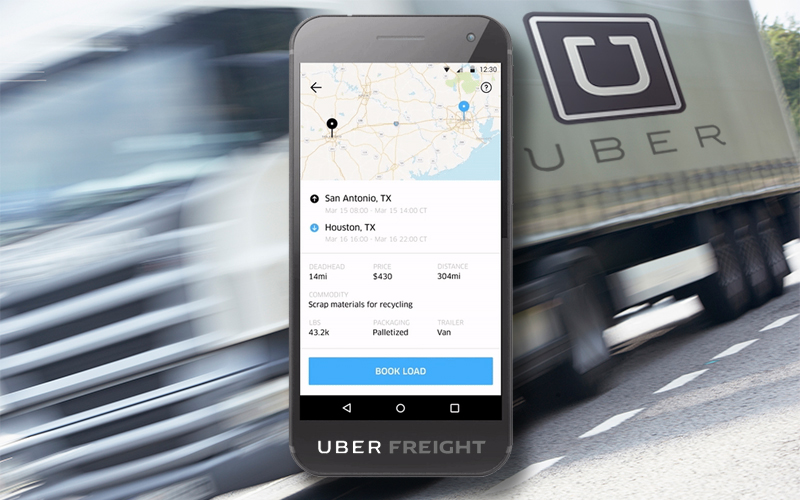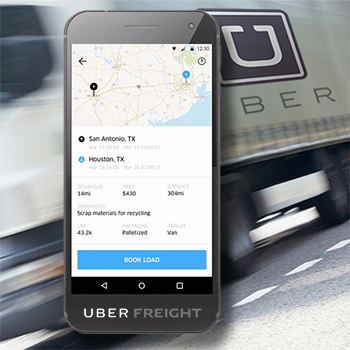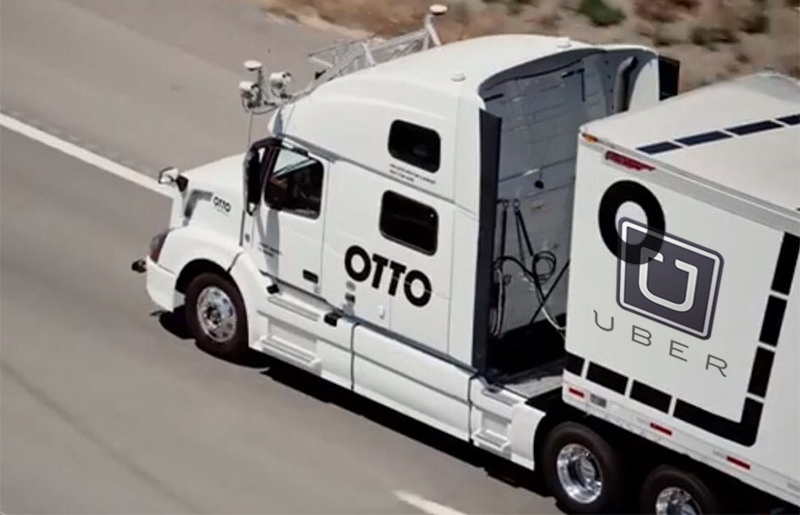Uber Freight Makes Official Entrance into Trucking

Uber has officially launched Uber Freight, the company’s new service that will match truckers with companies who need cargo shipped across the country.
After getting a peek from Travis Kalanick earlier this month, ubiquitous ride-sharing service Uber said this week it has officially entered the freight transportation arena, specifically truckload brokerage, with the introduction of Uber Freight.
In a blog posting, Eric Berdinis, Uber Freight product manager, wrote that Uber Freight is an app that matches trucking companies with loads to haul, explaining that it takes the guesswork out of finding and booking freight, which is often the most stressful part of a driver’s day.
“What used to take several hours and multiple phone calls can now be achieved with the touch of a button,” he explained.
“Uber Freight aims to empower truck drivers and small truck companies to run and grow their business.”
As for how the Uber Freight app works, Berdinis’s blog said that vetted users download the app, search for a load, and tap to book it, which is followed by a rate confirmation within seconds that eliminates a common anxiety in trucking about whether or not a load is really confirmed.
What’s more, he said that rather than the common practice of a trucker waiting 30 days or more to get paid, Uber Freight is “committed to paying within a few days, fee-free, for every single load,” and “[w]hen things don’t go as planned or drivers have to wait longer than expected, we pay for that, too,” with accessorial rates published on the Uber Freight blog and Website.
Today & tomorrow, we aim to empower a community of carriers w/ transparency & reliability. Sign up: https://t.co/KfuyqEk6TA #driverfocused pic.twitter.com/gMlZjl4qj1
— Uber Freight (@UberFreight) May 18, 2017
Uber has had its sights on the truckload brokerage market for a while now, with a September 2016 Reuters report noting it was keen on becoming a freight hauler (through its acquisition of Otto, a self-driving truck startup for $680 million in August 2016) and a technology partner for trucking.
The report added that Uber has pitching its services to shippers, truck fleets, and independent drivers, not just to outfit trucks with self-driving technology but also to be a player in the highly competitive $700 billion truckload brokerage arena, too, which is replete with major players such as C.H. Robinson Worldwide, XPO Logistics, Echo Global Logistics, and many other players.
Read: Putting the Ever Expanding Truckload Brokerage Business into Perspective
In an interview with Logistics Management, Uber’s Berdinis said that the company has been testing its freight platform over the last several months.
“We firmly believe we can make a significant impact in the future of trucking with a new way of booking freight and a new way of connecting small fleets and owner-operators with the large tail of capacity out there in the market to the community of shippers that don’t traditionally have the resources to go out and find capacity,” he said.
“Small fleets, with ten trucks or less, make up 90 percent of the registered motor carriers in the country, but, of course, a large Fortune 500 or mid-market company would not be contracting with these small fleets.”
By building an app, Berdinis contends Uber believes it can finally reach into that carrier pool and be welcoming and provide trust to the small fleets, with those fleets bringing the same level or higher service to shippers.
Prior to this week’s launch, Uber has been doing a pilot program with a handful of U.S.-based shippers, ranging from small ones to Fortune 500 companies, as well as a number of small carriers, many of which are Texas-based in the triangle between Dallas, Houston, and San Antonio.
Uber is also handling freight moves in California, the Midwest, and other part of the country, too. Uber Freight’s current offices are in San Francisco and Chicago.
As for how Uber Freight plans to differentiate itself in a crowded truckload brokerage market, Berdinis said that it will focus on the driver and a small fleet, noting that owner-operators may be viewed as a dying breed these days, due to the challenges in finding consistent freight, which relies on relationships that keeps trucks running and business profitable.
“By bringing these driver- and carrier-focused efforts together with our platform, we think we can build these small businesses and keep that capacity growing and thriving,” said Berdinis.
Addressing pricing, which Berdinis said has long been one of Uber’s strongest suits, as evidenced by its surge pricing model for its ridesharing business. The same leadership team that built that pricing model, led by Kevin Novak, is now focused solely on freight opportunities.
“We think we have a really strong vision in how we price our loads in the market,” said Berdinis.
Uber Freight’s initial focus is on the two most common freight types in the U.S., dry van and refrigerated (reefer), which offers a lot of space to route and optimize movements of these small fleets using the app, as well as provide ways to visualize and guarantee the highest levels of on-time performance for its shippers, he added.
And going into this space and doubling down on small fleets and creating a top quality service to its shipper base offers up plenty of room for growth.
Looking ahead, he said there are other freight opportunities it will vet in the future, like flatbed, LTL, and bulk, but at the moment Uber Freight will continue to focus on building out capacity with its dry van and reefer program.
When asked how many carriers are registered for the Uber Freight app, Berdinis declined to disclose a specific number, but he said that since putting up its splash page late last year the amount of inbound from both shippers and carriers “has been pretty overwhelming to the point where we had to scale up operations and open up our Chicago office in order to handle demand with plans to continue that pace at an extremely high trajectory,” which has led Uber to ramp up its carrier and shipper bases.
While Uber Freight has only recently made its official entrance into the market, a 2016 report from supply chain consultancy Armstrong and Associates, which was based on feedback from 27 companies providing Uber for Trucking services, or “Digital Freight Matching” (DFM), which Armstrong said reflects these types of services far more accurately was pretty telling.
“One of the key components of Uber’s model is the commodity-like nature of the ride-hailing service,” Armstrong said.
“The principle behind Digital Freight Matching may be simple, but the trucking industry is not. Domestic transportation is not a simple commodity. Complexities arise in the form of specialized equipment types, shipments transported via multiple modes, and necessary exception handling for service issues such as equipment breakdowns. Shipments are high-value and time sensitive. Placing an Uber-like app atop a complex industry doesn’t truly address the problem. Shippers and Carriers alike will be disappointed if this is the extent of the ‘solution.’” Evan Armstrong, President, Armstrong & Associates
Related Article: Uber Freight: Another “Uber-for-Trucking”?
Related White Papers
Beyond Shovel-Ready: The Extent and Impact of U.S. Infrastructure Jobs
This report sheds new light on the widespread contributions that infrastructure jobs make to the nation’s economy, including their importance at the metropolitan level. Download Now!
Mapping Freight: The Highly Concentrated Nature of Goods Trade in the United States
This report sheds new light on the widespread contributions that infrastructure jobs make to the nation’s economy, including their importance at the metropolitan level. Download Now!
Self-Driving Vehicles in Logistics
This report sheds light on various best-practice applications of self-driving vehicles in various industries today, and also reveals a detailed look into the use cases of self-driving vehicles across the entire logistics value chain. Download Now!
Your Guide to Upcoming Trucking Regulations
New regulations are anticipated to decrease the driver pool and truck capacity, which could ultimately disrupt over-the-road shipping, this paper is a guide to understanding and navigating the driver shortage and trucking regulations. Download Now!
Truck Driver Shortage Analysis
According to analysis by the American Trucking Associations, the shortage of truck drivers has grown to nearly 48,000 and could expand further due to industry growth and a retiring workforce. Download Now!
Article Topics
Armstrong and Associates News & Resources
Armstrong report takes a look at a ‘downshifting’ in the global 3PL market Sizing up the 3PL Market with Evan Armstrong Ecommerce and Outsourcing Fueling Revenue Growth for Third-Party Logistics Providers Uber Freight Makes Official Entrance into Trucking Armstrong & Associates 2017 Top 50 U.S. and Global Third-Party Logistics Providers Keep it Running: The Quintessential Spare Parts Logistics Report Armstrong & Associates Releases “Keep it Running: The Quintessential Spare Parts Logistics Report” More Armstrong and AssociatesLatest in Transportation
Baltimore Bridge Collapse: Impact on Freight Navigating Amazon Logistics’ Growth Shakes Up Shipping Industry in 2023 Nissan Channels Tesla With Its Latest Manufacturing Process Why are Diesel Prices Climbing Back Over $4 a Gallon? Luxury Car Brands in Limbo After Chinese Company Violates Labor Laws The Three Biggest Challenges Facing Shippers and Carriers in 2024 Supply Chain Stability Index: “Tremendous Improvement” in 2023 More TransportationAbout the Author





















